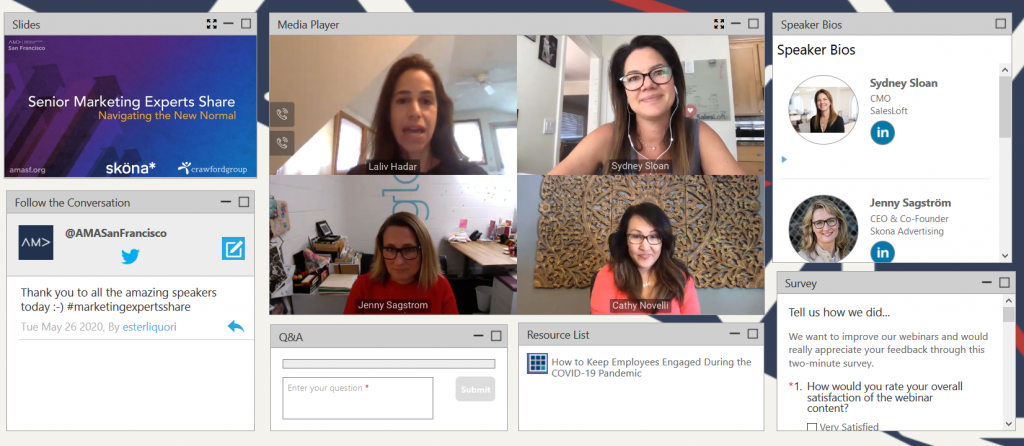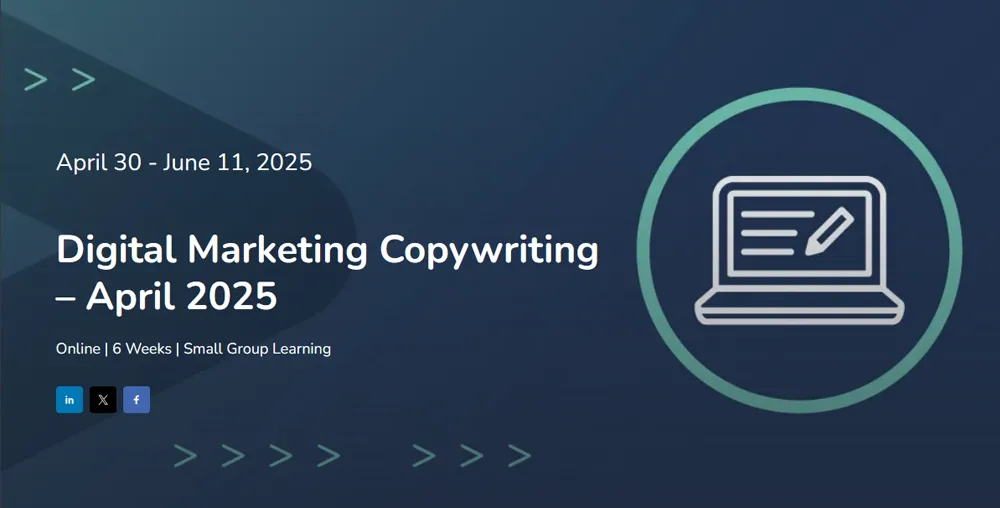In the shadow of an unprecedented period full of new challenges and alterations to social norms, there is a degree of solace in the knowledge that businesses still need to exist and people still need to work.
Embracing these challenges and looking not to survive, but rather to thrive through them, the San Francisco chapter of the American Marketing Association held a virtual fireside: Senior Marketing Experts Share: Navigating the New Normal. Moderated by Laliv Hadar, VP of Marketing & Brand at InVision Communications, the panel discussed some of the major questions on how to work with a consumer market that is rapidly changing.
With a panel consisting of three top minds in the field of marketing, currently leading teams at SalesLoft, Sköna, and Rakuten, each speaker was able to shed light on how their respective organizations are navigating through the recent choppy waters and gave tips on best practices.
Breaking it down into the basics, here are some best practices every company should keep top of mind when marketing during a global pandemic.

Attention on Accounts
All three panelists agreed that honing in on primary accounts and ensuring they are receiving their due support is pivotal for these coming months.
Sydney Sloan, CMO at SalesLoft, shared her company’s tier approach to ensuring that all accounts are receiving communication and attention that is tailored to their needs: a quarterly summit targeting a specific audience with the capability of having thousands of (virtual) attendees, bi-weekly webinars focused on specific target accounts with open registration but capped attendance closer to a couple dozen, and lastly, “one to few” experiences for accounts in the top tier including networking chats and brainstorms.
Account-Based Marketing thrives in an environment such as this one, where the focus may be less on increasing the quantity of leads and more on guiding them further down the sales funnel.
In lieu of being able to take a top tier account out for dinner, consider sending dinner to their family through your favorite delivery app or allowing them to choose their own favor which can be sent to their home. Not being able to physically visit does not diminish the importance of human connection, nor do virtual conference calls always meet that need.

Brand Building
While this time is opportune to analyze your brand’s message and to adapt it to the needs of your audience base, Jenny Sagström, CEO of Sköna, outlined the importance of ensuring that brands are keeping in mind the “fine balance” between being relevant to consumers and coming off as opportunistic. As an example, the beginning of the Coronavirus crisis brought not only swift change but also countless emails from companies long-forgotten, informing their entire contact list on how they planned to handle the COVID-19 crisis. Hindsight illustrates that this initial response for most companies to feel on-top of communicating with their audience led to a consumer base that was weary far too early.
While saluting front-line workers can be powerful and impactful, if a brand has not laid the groundwork to promote such a narrative, then a consumer is more likely to read it as inauthentic. Instead, Cathy Song Novelli, VP of Marketing & Communications at Rakuten Ready notes, the priority to make consumers feel safe and good interacting with the brand, however that looks for their specific brand personality, is more likely to ring true and have the sought-after impact.
Consistency is increasingly key. The panelists noted that a number of their clients or connections are using this time to re-do their websites, re-evaluate their brand mission, and overall “look after their own house.” This period does not need to be one of stagnation; instead, now is the time to do a deep Spring cleaning and recycle any projects or brand words that no longer spark joy.
As Sagström succinctly explained, creating an aspirational brand that people want to be associated with will go farther to create relationships and lanes for opportunity than a singular aspirational event is likely to.

Content Creation
If there was one point to which all panelists fully agreed, it was this: these current challenges are not insurmountable. If anything, the lack of “snackable leads” that are a natural result of in-person events provides the opportunity for marketers to hone their craft and dial in on the tried-and-true methods of marketing.
Content creators should take care to focus on creating engaging content from a standard marketing point of view, pointing back to the fundamentals. Not to mention that it saves cost to be digital rather than in-person!
Sagström spoke to the importance of creating “quick hits” that will assist clients with generating responses while acknowledging that their customers are also human beings with complex and unique challenges. Instead of sending an article on how to calculate one’s ROI, perhaps it is more prudent at this time to send a creative coloring book for the children of customers who are confined at home. Instead of sending packages to an empty office building, save them the trip and see how you can send goodies to your top-tier accounts at home. If a company is seeking to provide use to their clients and customers, then that use must be adapted to the most pressing needs.
If creating new content feels unrealistic at this time, the panelists shared that some of their clients have found success in repurposing old campaigns to give them the space and leeway they need for internal review and analysis.
The more companies are able to empathize with their audiences and provide for their needs, the better our inboxes and working relationships will be for it.

Demand Generation
One element to marketing that has certainly not wavered? The need to generate demand.
Focusing on specific accounts may be prudent for some, but for those who are seeking to grow and generate more leads there are any number of creative approaches. Now is the time to ensure that the sales and customer teams are aligned with marketing objectives. One tip involved creating a special offer that can be released to the entirety of the sales team to be given out indiscriminately to loyal customers. Another panelist discussed the importance of being able to balance dual goals by pivoting between marketing and growth-hacking depending on the flow of the economy that very week.
Through conducting their own A/B testing, Sloan and her team were able to discover that they received a 40 percent lower response rate on emails if the title had a mention of COVID-19. Surrounded by content inundated with COVID-19 and the global crisis, it’s no wonder that some consumers are unresponsive to more of the same.
The key to generating demand at present lies in compensating for what people are missing–face-to-face interactions, quiet time while the kids are at sports practice, their favorite lavender latte, etc.–and providing them with an adapted version of the same experience.

Experience Marketing
If it weren’t for Zoom, Slack, and all our other favorite video chat platforms, sheltering in place would certainly be a lot more lonely.
While virtual meetings and competing for WiFi connection may not be ideal, it is certainly what we can expect to be the norm for the foreseeable future. One panelist shared the details of a survey concluding that consumers are generally not comfortable with the idea of attending tech events for the rest of 2020, and even responded unfavorably toward companies at the idea of being invited to a tech event in 2021.
Having a successful virtual event, the panel agreed, hinges on having a base of interested consumers who are willing to adapt to a new consumer behavior. Given that attendees are signing on from the comfort of their own home, experiences must be engaging enough to pull consumers out of their bubble. Hosts must ensure that they are focusing on quality, brevity (20 minutes or so), and engagement if they want to hold the interest of participants.
Moreover, it is important to understand that the results of a virtual conference or virtual booth will not be equivalent to that of an in-person experience. Opportunities for networking have maintained their value and are likely to draw attendees to participate, but informational sessions may be less so. As aforementioned, giving attention to the needs of specific accounts is likely to be more productive than a one-size-fits-all “we’re here for you” campaign.
Flexibility
Finally, to round out the list, perhaps the largest takeaway that was an undercurrent to each conversation during the panel: the need for flexibility.
Looking at the success of brands such as Rakuten during these last few months, Novelli hugely credited the company’s ability to pivot and change their approach almost weekly. If we are operating under the norm that a typical marketing plan should stretch out six months as a maximum, it can safely be assumed that, at least for now, capping out at three months is about as far as we can go.
Additionally, honing in on regional needs will be vital for creating a strong basis for all marketing. While some states have chosen to open up retail at a faster pace than others, it does not mean that the citizens living in those places are prepared to hear a promotion that pushes in-store shopping.
Conclusion
Ultimately, when looking to navigate the new normal, there is no one path to follow. Now is the time to roll up your sleeves and be prepared to reflect and adapt with each new fork in the road
Thank you to our speakers:

Sydney Sloan
CMO
SalesLoft
Sydney Sloan has extensive global experience marketing software applications that help people communicate and collaborate more effectively. Sydney is currently the Chief Marketing Officer at SalesLoft and has held senior leadership roles at Adobe and Alfresco. She is driven by a passion for discovering how companies can deliver exceptional customer experiences that align with rapidly changing expectations in an ever-changing technology landscape. Utilizing a variety of digital touchpoints and account-based strategies, she has established proven techniques for increasing customer engagement and loyalty. Her thought leadership in the field has confirmed Sydney as a leader in B2B marketing strategy.

Jenny Sagström
CEO & Co-Founder
Skona Advertising
Jenny Sagström has several years of experience within the field of entrepreneurship. Sköna is a San Francisco based high-tech B2B business which works with advertising and design shops. With almost 20 years of making a living in the San Francisco Bay Area, Jenny knows the market and area very well and she is an entrepreneur in one of the most dynamic environments in the world. She has great knowledge within the fields of: start-ups, marketing, entrepreneurship, brand strategy and business development.

Cathy Song Novelli
VP Marketing and Communications
Rakuten Ready
Cathy Song Novelli serves as the Vice President of Marketing + Communications at Rakuten Ready. In this role, she oversees all owned, earned, and paid media, and manages all marketing organizations. Cathy has two decades of experience in marketing, advertising, and media. Prior to joining Rakuten Ready, Cathy held executive and leadership roles at Quantcast, Pandora, Yahoo, MySpace and Say Media. Before she led marketing and monetization strategy at these publishers and platforms, she spent years in advertising sales, as well as on the agency side, planning and buying media for clients such as Hewlett Packard and GM.

Laliv Hadar
VP Marketing & Brand
InVision Communications
Laliv Hadar is a high-performing B2B Sales and Marketing executive hailing from prominent media companies and agencies, and high-profile, venture-backed start-ups. She has a successful track record crafting marketing strategy, communications, sales development and marketing programs that drive awareness and revenue growth for brands. She has broad industry relationships, and has proven herself as a successful leader and people developer/mentor. Laliv spent her early days at AOL, Time Warner and Yahoo!, and more recently leading integrated marketing for Wikipedia brand Fandom Wikia. She’s now VP of Marketing and Brand for engagement solutions leader InVision Communications.
A special thanks to our webinar sponsors:










Comments are closed.